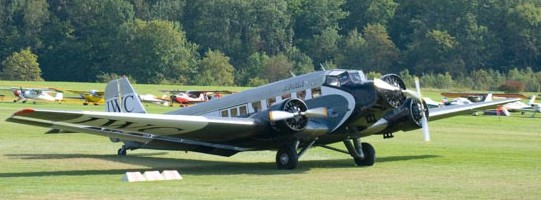|
|
Unsere Ziele sind höher gesteckt,
nämlich das Flugzeug zu benutzen,
um die Menschen und Nationen
einander näher zu bringen.
Our goals are set higher,
namely, to use the airplane to bring people and nations closer to each other.
Hugo Junkers (1859 – 1935)
|
After the merger of Deutscher-Aero-Lloyd and Junkers-Luftverkehrs AG to form Deutsche Luft Hansa AG in 1926, Hugo Junkers had to find a new, profitable field of business, free from subsidies and patronizing others. With his very good international contacts all over the world from the time of Junkers-Luftverkehrs AG and the experience gained in the passenger and freight business, e.g. with Asia, he turned to the construction of cargo aircraft. The Ju 52/1m, a single-engine Ju 52, was initially built in 1928, but failed to achieve commercial success. Commercial success did not materialize until the 3-engine Ju 52/3m, which was developed from April 1931. Orders from Europe and Latin America quickly followed.
 In Germany, the aircraft quickly prevailed over its competitors from Dornier and Fokker, and from May 1932 Deutsche Luft Hansa AG flew the Junkers Ju 52/3m. A rapid expansion of the route network followed, and all seemed right with the world for Hugo Junkers. Two years later, in 1934, he was expropriated by the Nazis, placed under house arrest and died a year later in Gauting. The Nazis were looking for a suitable bomber at the time. The Ju 52/3m was reconfigured and fitted with MG`s and a bomb bay. At the same time, new production facilities for the aircraft were opened. It was used militarily for the first time in the Spanish Civil War, but it was too slow and therefore vulnerable. As a transport aircraft, however, it soon formed the backbone of the German Air Force’s airlift capability. The aircraft was also built under license during WW2 in France as the AAC.1 “Toucan” and in Spain as the CASA 352, making a total of 4835 Ju 52/3m in many variants and under license. The last Ju 52 was retired by the Swiss Air Force in 1984.
In Germany, the aircraft quickly prevailed over its competitors from Dornier and Fokker, and from May 1932 Deutsche Luft Hansa AG flew the Junkers Ju 52/3m. A rapid expansion of the route network followed, and all seemed right with the world for Hugo Junkers. Two years later, in 1934, he was expropriated by the Nazis, placed under house arrest and died a year later in Gauting. The Nazis were looking for a suitable bomber at the time. The Ju 52/3m was reconfigured and fitted with MG`s and a bomb bay. At the same time, new production facilities for the aircraft were opened. It was used militarily for the first time in the Spanish Civil War, but it was too slow and therefore vulnerable. As a transport aircraft, however, it soon formed the backbone of the German Air Force’s airlift capability. The aircraft was also built under license during WW2 in France as the AAC.1 “Toucan” and in Spain as the CASA 352, making a total of 4835 Ju 52/3m in many variants and under license. The last Ju 52 was retired by the Swiss Air Force in 1984.
 Since then, you could take off with the “Tante Ju” to fantastic sightseeing flights. But lately it has become quiet, the unique sound of the engines was missing. In South Africa the only airworthy Ju 52 in Africa was grounded, the Swiss “Ju-Air” lost an aircraft in a tragic accident and the D-AQUI of the Lufthansa Foundation remains on the ground and has found a new home in Paderborn. It is getting quiet around the aunt Ju …
Since then, you could take off with the “Tante Ju” to fantastic sightseeing flights. But lately it has become quiet, the unique sound of the engines was missing. In South Africa the only airworthy Ju 52 in Africa was grounded, the Swiss “Ju-Air” lost an aircraft in a tragic accident and the D-AQUI of the Lufthansa Foundation remains on the ground and has found a new home in Paderborn. It is getting quiet around the aunt Ju …
TIME TO HEAT UP THE AMATEUR RADIO BANDS AND MAKE SOME NOISE FOR A GREAT AIRCRAFT AND A GREAT ENGINEERING ACHIEVEMENT!

